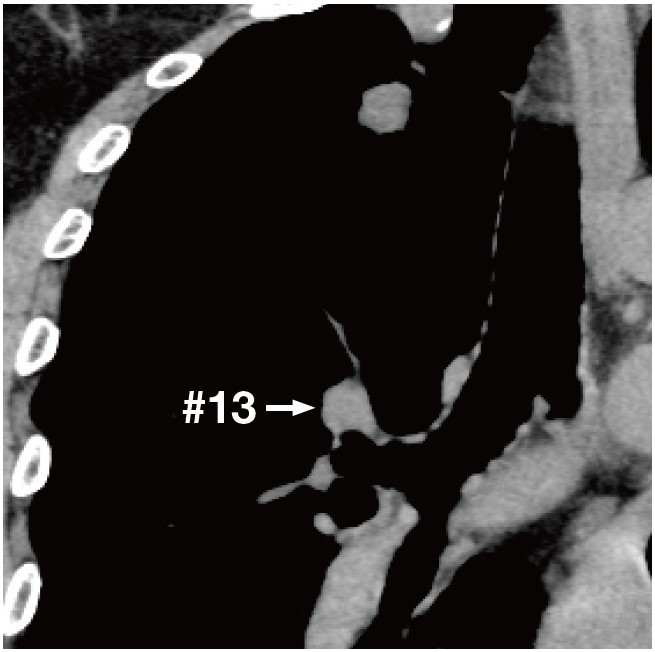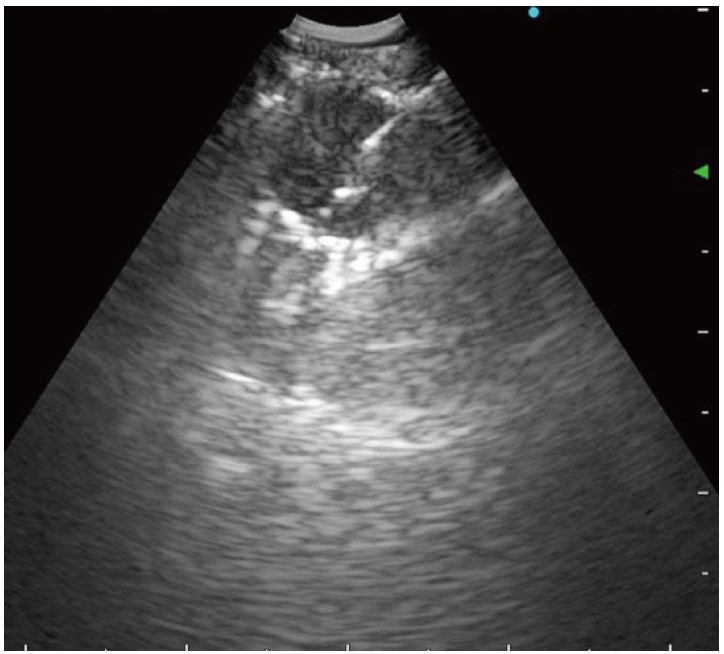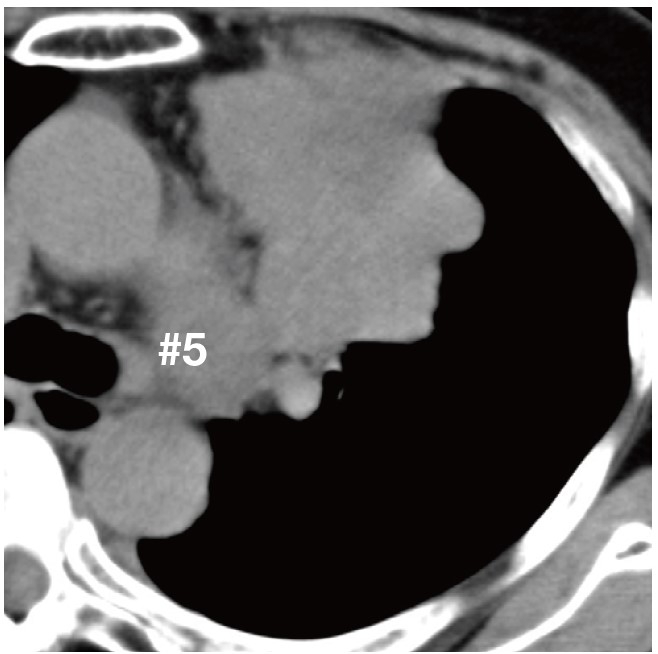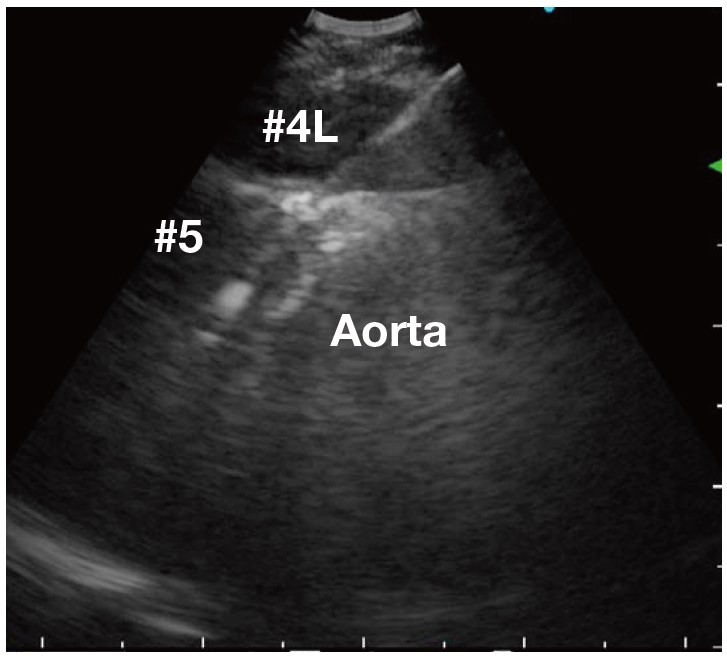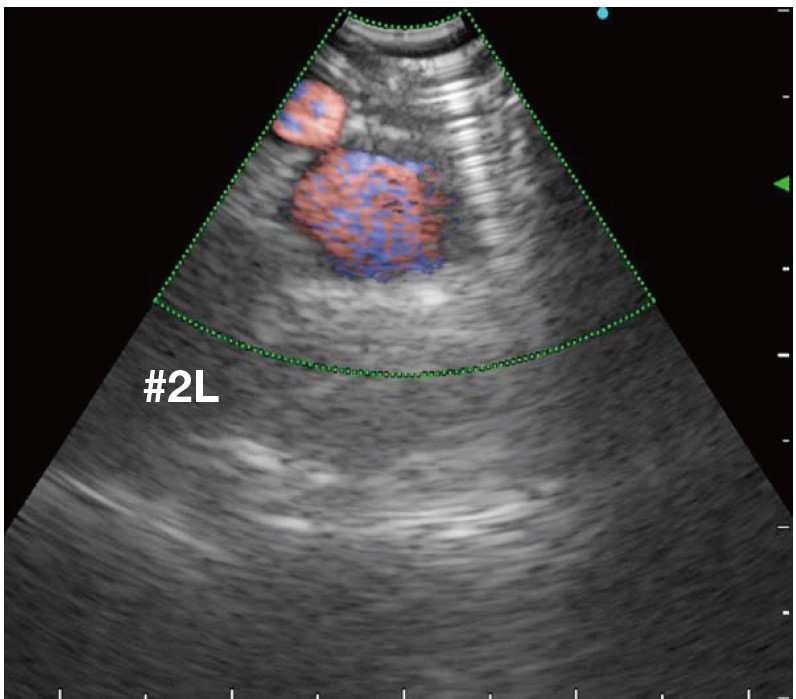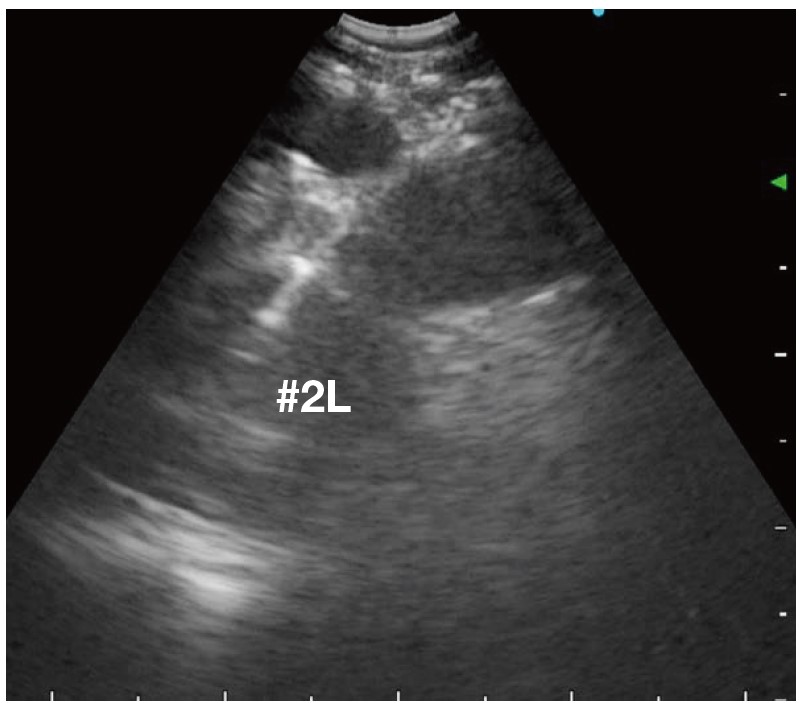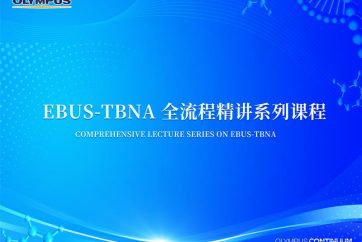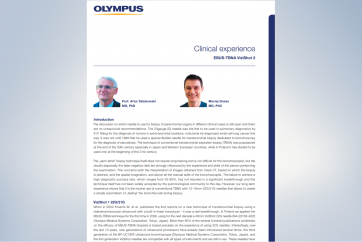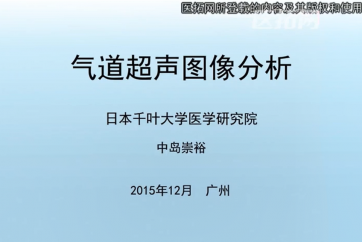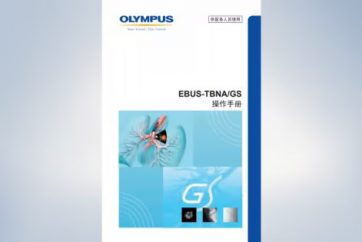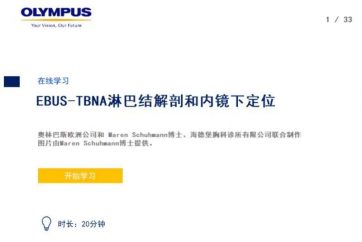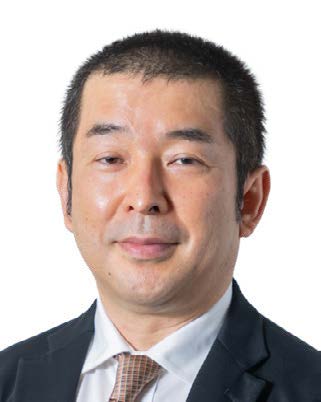
Department of Respiratory Medicine,
National Hospital Organization Nagoya Medical Center
1 ViziShot 2 Introduction
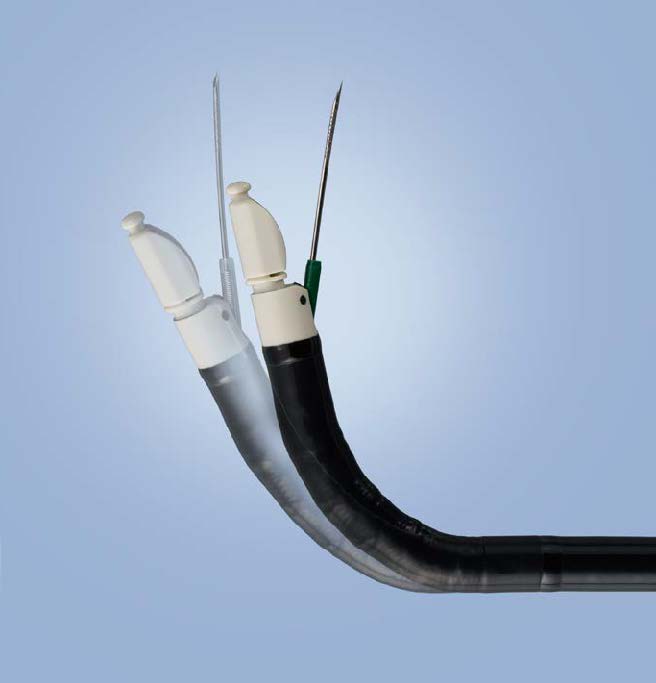
The Olympus ViziShot 2 series needles are designed to offer improved flexibility over the original ViziShot series needles, enabling easier access to lymph node stations that had been considered difficult-to-reach until now. When performing EBUS-TBNA procedures, it is necessary for the EBUS scopes to be able to access multiple different locations within the tracheobronchial tree and puncturing the bronchial wall while avoiding cartilage and blood vessels. Therefore, the operability of the EBUS scope is a crucial factor for a successful EBUS-TBNA procedure. With the improved flexibility of ViziShot 2, the resistance from the EBUS scope remains low even under acute angulation, facilitating easier sampling of specimens also in challenging locations. The ViziShot 2 series’ needle-tip was re-designed and manufactured to be sharper than ViziShot, further enhancing the puncture capability.
2-1 Clinical Case Report of ViziShot 2 ~ Sampling of Lymph Nodes where ViziShot 2’s Improvements are Appreciated ~
With the enhanced flexibility and puncture capability of ViziShot 2 over ViziShot, clinical usability has improved. When compared with the ViziShot under the same conditions, ViziShot 2’s maximum angulation was reported to have increased by 15 degrees 1). The maximum angulation of EBUS scopes itself has also improved from 120 degrees of the previous generation (Olympus BF-UC180F/260FW) to 160 degrees with the latest third generation (Olympus BF-UC190F/290F). Combining the new generation ViziShot 2 needles with the latest generation of EBUS scopes, we can now perform EBUS-TBNA in lesions located in places once considered inaccessible to sample due to the angulation required. Until now, lymph node #4L and #10R are sampleable, however, puncturing from an acute angle is essential, and often needles failed to reach their target 2). After switching to ViziShot 2, the technical difficulties have drastically been reduced when puncturing these lymph nodes and the number of cases that were not be able to be sampled are now very rare. Besides being able to access #4L and #10R easily, ViziShot 2 also contributed to the improvement in diagnostic yield when sampling lesions located in the upper lobes (Image 1), lymph node #5 via esophagus (EUS-B-FNA) (Image 2) 3) and other lesions in locations of which were once considered difficult-to-access by EBUS-TBNA.
Along with the improvement in flexibility, ViziShot 2 series needles also feature a sharper needle-tip to enhance the puncture capability, a redesigned handle to provide easy needle operation, a double-locking mechanism to improve safety during the procedure, an easy to distinguish green coloured sheath to enhance the visibility under endoscopic view, a new sheath material to minimize sheath movement, and a reduced stylet’s diameter for smoother stylet control.
For novice users, all of these features contribute to the overall simplification of the procedure, as well as ensuring high safety and accuracy of EBUS-TBNA.
2-2 Technical Suggestions for ViziShot 2 ~ Successfully Retrieving Structural Samples ~
With the advancement of treatment methods of malignant tumors, along with improvements in histological classification, molecular marker testing has also become a must. When performing endobronchial sampling with bronchoscopes, it is critical to retrieve structural specimen, which also applies to EBUS-TBNA. To successfully collect the histological specimen, we focus on using long strokes, sampling from as close to the proximal end of the target lesion to as close to the distal end of the lesion as possible, also, agitating the needle fast and changing direction with each pass (fanning technique). When identifying the target location for puncturing, we want to look for and sample from blood rich locations of the target lesion under the Doppler Mode, making sure to also avoid blood vessels and prevent potential hemorrhage, necrotic and cyst locations to reduce the risks of severe infections. During sampling start off with light negative pressure suction, if the specimen retrieved initially contained high amount of blood, decrease the negative pressure for the next puncture; if the volume of the specimens collected is insufficient, increase the negative pressure. When extracting the specimen collected within the ViziShot 2 needle, expel directly onto a slide glass with the stylet, while preserving the histological component of the specimen into a formalin container. Number and label each specimen prior to sending it off to pathology. If there is suspicion for malignancy, have ROSE (Rapid-On-Site-Evaluation) ready to promptly evaluate the adequacy of the specimen obtained to assess whether further sampling is necessary or the necessity of adjusting sampling technique accordingly.
3 Choosing Between the Gauges ~ 19G, 21/22G, 25G ~
To date, there is no clear evidence showing difference in diagnostic yield between usage of different manufacturers’ needles for sampling. Therefore, for almost all the cases we perform, we prioritize using ViziShot 2 22G over the other needles as our go to needle for its superior balance between specimen collecting effectiveness, puncture capability, flexibility, and cost. The performance difference between ViziShot 2 21G and 22G is minimal and choosing between the two gauges of ViziShot 2 is very subjective and simply comes down to personal preference.
ViziShot 2 FLEX is currently the only 19G EBUS-TBNA needle available in Japan at the time of this testimonial.
When compared to the 22G needles, the inner diameter of the needle is 66% larger, promising larger specimens when sampling for lymphoma and rare cases where benign/malignant tumor are suspected, large specimens are necessary. Whereas the 22G may not be enough, the ViziShot 2 FLEX will be more promising for collecting adequate specimens. Despite the larger needle diameter of ViziShot 2 FLEX, the spiral laser cut design allows for flexibility that exceeds the 22G needle, capable to puncture lesions with effectiveness at locations where 22G
cannot reach due to the acute angles (Image 1,2).
As for ViziShot 2 25G needle, the flexibility further surpasses ViziShot 2 FLEX and along with its superior puncture capability, it is best suited for the most difficult cases requiring puncturing under extreme angulation (Image 3).
Along with the thin diameter, the risk for hemorrhage is lower than with other gauges, making the 25G one of our main options when performing cases with lesions located in the vicinity of main blood vessels and cases which require puncturing through blood vessels (Image 3).
4 Conclusion
Comparing ViziShot 2 to ViziShot, the flexibility and puncture capability of ViziShot 2 has improved. Cases which were once considered to be difficult to approach with ViziShot are now much more promising with ViziShot 2. The newly designed handle also provided easier handling leading to the consistency and safety when performing the procedure. Olympus provides 4 different gauges in their lineup to address different types of cases. Out of these, the ViziShot 2 22G needle offers superior balance between performance and cost, and it is fair to say ViziShot 2 22G is the de facto needle for EBUS-TBNA procedures.
National Hospital Organization Nagoya Medical Center
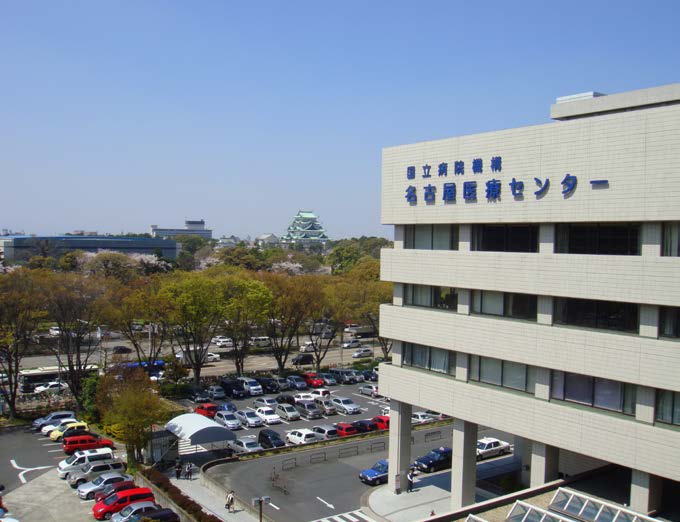
The National Hospital Organization Nagoya Medical Center is a city hospital located in the heart of Nagoya.
The Respiratory Medicine Department plays a central role for the respiratory interventions in this region, accepting referrals from nearby hospitals for bronchoscopic examinations and treatments.
Former chief physician Dr. Hideo Saka, also served as the immediate past-chair of the World Association for Bronchology and Interventional Pulmonology (WABIP), with many physicians from both domestic and abroad coming over to Nagoya Medical Center to study and master in respiratory interventions.
References:
1. Yang J, De Cardenas J, Nobari M, Miller R, Cheng G. Narrative review of tools for endoscopic ultrasound-guided biopsy of mediastinal
nodes. Mediastinum. 2020 Dec 30;4:34.
2. Torii A, Oki M, Yamada A, Kogure Y, Kitagawa C, Saka H. EUS-B-FNA enhances the diagnostic yield of EBUS bronchoscope for intrathoracic
lesions. Lung. 2022;200(5):643-648.
3. Oki M, Saka H, Kogure Y. Transesophageal needle aspiration using a third-generation Olympus ultrasound bronchoscope for subaortic
lesions: a report of two cases. Transl Lung Cancer Res. 2019;8(6):1152-1156.
Disclaimer
Any content or information (“Content”) presented herein is illustrative in nature and does not guarantee or represent specific information, outcomes, or results. Olympus Medical Systems Corp. and its parents, subsidiaries, affiliates, directors, officers, employees, agents, and representatives (collectively “Olympus”) does not represent to or warrant the accuracy or applicability of the Content. Under no circumstances shall Olympus be liable for any costs, expenses, losses, claims, liabilities, or other damages (whether direct, indirect, special, incidental, consequential, or otherwise) that may arise from, or be incurred in connection with, the Content or any use thereof.
- Keyword
- Content Type

